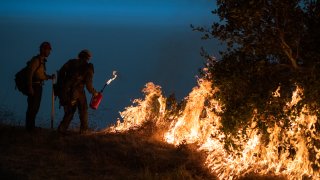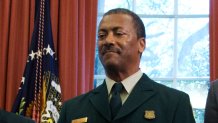
Federal officials are warning that expanding drought conditions coupled with hot and dry weather, extreme wind and unstable atmospheric conditions have led to explosive fire behavior in the southwestern U.S., where large fires continued their march across New Mexico on Friday.
Crews also battled blazes in Texas, Colorado and California, where forecasters issued red flag warnings due to elevated fire danger across the region.
Firefighters at the biggest fire in the U.S. worked northeast of Santa Fe, New Mexico, on Friday to reinforce fire lines threatened by winds that gusted in excess of 40 mph (64 kph) and forced the grounding of air tankers and helicopters by midday.
U.S. Forest Service Chief Randy Moore cited the extreme conditions Friday in announcing a pause on prescribed fire operations on all national forest lands while his agency conducts a 90-day review of protocols, decision-making tools and practices ahead of planned operations this fall.
Get New England news, weather forecasts and entertainment stories to your inbox. Sign up for NECN newsletters.
“Our primary goal in engaging prescribed fires and wildfires is to ensure the safety of the communities involved. Our employees who are engaging in prescribed fire operations are part of these communities across the nation,” Moore said in a statement. “The communities we serve, and our employees deserve the very best tools and science supporting them as we continue to navigate toward reducing the risk of severe wildfires in the future."

The U.S. Forest Service has been facing much criticism for the prescribed fire in New Mexico that escaped its containment lines in April and joined with another blaze to form what is now the largest fire burning in the U.S.
Changing Climate
In-depth coverage of our changing climate and environmental issues
Moore said that in 99.84% of cases, prescribed fires go as planned and they remain a valuable tool for reducing the threat of extreme fires by removing dead and down trees and other fuel from overgrown forests.
New Mexico Gov. Michelle Lujan Grisham, who praised the temporary suspension of intentionally set fires, said it's clear that well-managed prescribed burns can help improve forest management.
But "it is critical that federal agencies update and modernize these practices in response to a changing climate, as what used to be considered extreme conditions are now much more common,” she said in a statement Friday.
“The situation unfolding in New Mexico right now demonstrates without a doubt the grave consequences of neglecting to do so," she said.
Wildfires have broken out this spring earlier than usual across multiple states in the western U.S., where climate change and an enduring drought are fanning the frequency and intensity of forest and grassland fires. The nation is far outpacing the 10-year average for the number of square miles burned so far this year.
Nationally, more than 5,700 wildland firefighters were battling 16 uncontained large fires that had charred over a half-million acres (2,025 square kilometers) of dry forest and grassland, according to the National Interagency Fire Center.
One that broke out Friday in the foothills of the Sierra Nevada about 80 miles (129 kilometers) north of Sacramento forced some evacuations and closed a state highway, but no structures had been damaged and fire officials said they were making progress on the 20-acre (8-hectare) blaze.
The biggest U.S. fire has blackened more than 474 square miles (1,228 square kilometers) of northern New Mexico. State officials have said they expect the number of homes and other structures that have burned to rise to more than 1,000 as more assessments are done.
In West Texas, most of which remained under a red flag warning Friday, officials said firefighters were making progress in containing a wildfire near Abilene that has destroyed at least 27 structures.
It hadn't spread more than the 15 square miles (39 square kilometers) it consumed on Thursday and evacuations were lifted at Buffalo Gap.
Several days of rain and milder temperatures are forecast to return there by Sunday, the National Weather Service said.
Associated Press writers Terry Wallace in Dallas and Scott Sonner in Reno, Nevada, contributed to this report



